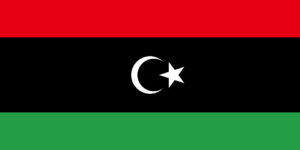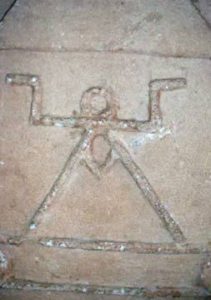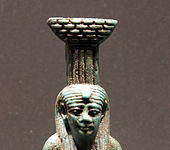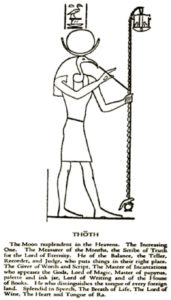Red Pill Alchemy Volume 1
Can We Beat The Matrix?
For ages, the moon has been adorned throughout many cultures. Due to a lack of understanding of ancient practices, there are many misconceptions about how we view ancient cultures today. There are many people that belong to the so-called conscious community for instance that belittle those that still adhere to religious texts such as the Bible, Quran, or Torah. Unbeknownst to many of this newfound group of hallelujah to Hotep faithful the ones they call their ancestors are the original creators of these allegorical myths. It is true that the three monotheistic religions were plagiarized from ancient stories. We must, however, adhere to the fact that the ancestral way was to teach the sciences in story form.
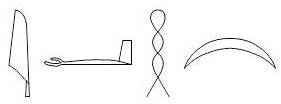
The Glyph For The Deity Iah As You Can See There Is A Crescent Moon
The moon has long been anthropomorphized to tell these greater mysteries. There are however many superstitions that have been passed down regarding the moon. Science seems to debunk all of these concepts so this is where intuitive thoughts and spiritual insight should be incorporated into a person’s views about the moon. It has been said throughout time that the moon can affect the way a person’s hair may grow. There have also been people that seem to think that certain animals in nature respond differently to the moon. There are some that tend to think that the moon is directly correlated to a woman’s menstrual cycle. Some people have even made the link between epileptic seizures and the moon cycle. Regardless of what people seem to adhere to one thing is for certain there should definitely be more incorporation of the moon’s cycles into our day to day affairs.
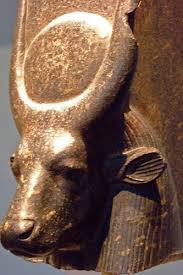
Hat-Hor/Het-Heru/Hathor Also Known As The Holy Heifer or The Cow That Jumped Over The Moon
The moon has been called many names in many different cultures. The moon has been made to be both masculine and femiNINE depending on the wisdom keepers of the cultures. For instance, in the ancient Egiptian or Kemetic culture alone, the moon can be attributed to Ausar/Osiris. Khonsu, Auset/Isis, Het-Heru/Hathor, Nephthys, Nebet, Neith/Nut, Iah, as well as Tehuti/Thoth. This ambiguity shows how complex the thoughts of the ancient cultures really were. These thoughts of sacred wisdom are called anthropocosmos. The idea that for each and everything on Earth there is a cosmic counterpart to such. This reasoning is why in the book of Matthew Yashua/Isa/Jesus told his disciples to “After this manner, therefore, pray ye: Our Father which art in heaven, Hallowed be thy name Thy kingdom come. Thy will be done, On earth as it is in heaven..“. This passage starts at Matt 6:9 because the 6 & 9 placed together to form the yin and yang symbol. This symbol is a symbol that is described in many ways but in this case, I will say it applies as a symbol of duality. This motif can mean heaven and earth, but it can also mean masculine and feminine! We must see the divine in both, however!
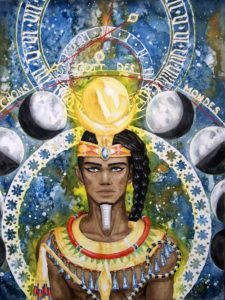
The Deity Khonsu An Embodiment Of The Moon
The moon has also been venerated in monotheistic religion as well. The word monotheism has its roots in the moon. The word itself related to the Greek god of sarcasm and pain called Monos. Their many other words related to the moon that we may never pay attention to as well. Take time to examine words like MONday, MONopoly, MONey, MONster, or deMON. These words are related to the moon as I explained in an earlier article on the ritual surrounding Kenneka Jenkins.
Previous Article Found Here
The Hebrew word Shad is said to mean breast in Hebrew according to Strong’s Concordance!
| Strong’s Concordanceshad: breastOriginal Word: שַׁד Part of Speech: Noun Masculine Transliteration: shad Phonetic Spelling: (shad) Short Definition: breastBrown-Driver-Brigg |
The Hebrew word for Almighty is, however, El Shaddai or Shaddy!

This image is a supposed image of the Greek goddess Artemis
her complexion is an admission in itself!
| Strong’s ConcordanceShadday: AlmightyOriginal Word: שַׁדָּי Part of Speech: Noun Masculine Transliteration: Shadday Phonetic Spelling: (shad-dah’-ee) Short Definition: Almighty |
Could this be the origin of a person of low morals being called Shady? Do note that the ancients saw the moon at differing times resembled a woman’s breast!
In Genesis 17:1 before the Bible was changed El Shaddy called herself “the god of many breasts”
Gen 17:1
When Abram was ninety-nine years old, the LORD appeared to him and said, “I am the Almighty God. Obey me and always do what is right.
17 + 1 = 18 or 6+6+6
This passage shows the connection to the Moon being that Abram was 99. This science is connected to the 99 attributes of Allah. In this realization, we see that one of the names of the moons in KMT was Iah! This AH ending is in the name Allah. So now you see why Abraham’s wife was named Sarah? This is also why the flags from Islamic countries dawn the crescent moon.
The respective flags for Pakistan and Libya
The respective flags from Malaysia and Turkey
We must also look at the scriptural names of many women ending the AH sound. Keturah, Delilah, Rebecca, Khadijah, and Fatimah, to name a few! In fact, in West Africa, the Yoruba goddess Yemeya is often connected to the Moon. The Ibo goddess Ala (pronounced Allah) is a moon deity. In Roman culture, the moon is called Luna. The Romans also called the moon Diana in some of their stories. Kazza is a name for the moon in Arturian culture. Raka and Chandra are both names used in Hindu culture. Chia and Huitaca are names used in the Muisca culture of the Andes. In Incan culture, the moon was named Mama Killa and Ka-Ata-Killa. The Mayans lived on a lunar calendar and they called the moon Maya! The Sumerians of Mesopotamia called the moon Inanna! The Lusitanian called the moon Ataegina.
The deities Tanit as Nut/Neith, Tehuti/Thoth, & Nut/Neith again as embodiments of the Moon
Lastly, the moon has often been associated with the cow in certain cultures. The ancient Egiptians called Het-Heru a lunar deity “the Holy heifer“. The children’s tale once told us that the cow jumped over the moon correct? What sound does a cow make Neo? Don’t they say “Moo”? In closing, I hope that this writing will help others garner a different perspective.
Moon Worship
The moon holds a mystical place in the history of human culture, so it’s no wonder that many myths — from werewolves to induced lunacy to epileptic seizures — have built up regarding its supposed effects on us.
“It must be a full moon,” is a phrase heard whenever crazy things happen and is said by researchers to be muttered commonly by late-night cops, psychiatry staff and emergency room personnel.
The human body is about 75 percent water, and so people often ask whether tides are at work inside us.
The moon and the sun combine to create tides in Earth’s oceans (in fact the gravitational effect is so strong that our planet’s crust is stretched daily by these same tidal effects).
Moon worship, adoration or veneration of the moon, a deity in the moon, or a personification or symbol of the moon. The sacredness of the moon has been connected with the basic rhythms of life and the universe. A widespread phenomenon, appearing in various eras and cultures, moon engendered a rich symbolism and mythology.
The moon is viewed in terms of the rhythmic life of the cosmos and is believed to govern all vital change. The cyclical process of disappearance and appearance of the moon is the basis of the widespread association of the moon with the land of the dead, the place to which souls ascend after death, and the power of rebirth. The lunar governance of this cycle likewise leads to association of the moon and fate.
The mythology of the moon emphasizes especially those periods when it disappears—the three days of darkness in the lunar cycle and eclipses. Both are usually interpreted as the result of battles between some monster who devours or slays the moon and who subsequently regurgitates or revives it. The interregnum is interpreted as an evil period necessitating strict taboos against beginning any new or creative period (e.g., planting or sexual intercourse). In some areas loud noises are part of a ritual activity designed to scare off the moon’s assailant.
Lunar deities, gods and goddesses who personify the moon and its cycles, are comparatively rare. In primitive hunting cultures the moon is frequently regarded as male and, particularly in regard to women, is understood as a preeminently evil or dangerous figure. In agricultural traditions the moon is usually regarded as female and is the benevolent ruler of the cyclical vegetative process.
Studies of full moon effects
Here are some of the reputable studies in peer-reviewed journals that have failed to find connections:
Epilepsy:
A study in the journal Epilepsy & Behavior in 2004 found no connection between epileptic seizures and the full moon, even though some patients believe their seizures to be trigged by the full moon. The researchers noted that epileptic seizures were once blamed on witchcraft and possession by demons, contributing to a longstanding human propensity to find mythical rather than medical explanations.
Psychiatric visits:
“The belief that the lunar cycle is associated with the onset and severity of psychiatric symptoms has persisted since the middle ages,” researchers write in 2014 in the journal ISRN Emergency Medicine. Has this belief been proved out by science?
A 2005 study by Mayo Clinic researchers, reported in the journal Psychiatric Services, looked at how many patients checked into a psychiatric emergency department between 6 p.m. and 6 a.m. over several years. They found no statistical difference in the number of visits on the three nights surrounding full moons vs. other nights.
For the 2014 study, researchers led by Varinder Parmar of Queen’s University in Ontario, Canada, looked at psychiatric emergency-department visits around the night of the full moon: six hours, 12 hours and 24 hours before and after a full moon. During the 12 hours before and after a full moon, EDs saw significantly more patients with personality disorders as well as with more urgent triage scores (those who needed more urgent care). However, fewer patients with anxiety disorders showed up during the 12 hours and 24 hours prior to and following the full moon.
Lunacy:
People don’t seem to be “howling at the full moon,” at least according to the research out there.
A review, called a meta-analysis, of 37 published and unpublished studies regarding a link between the full moon and “lunacy” as well as other behaviors found that just 1 percent of the change in activities considered “lunacy” — mental hospital admissions, psychiatric disturbances, crisis calls, homicides, and other criminal offenses, according to the researchers — could be attributed to the full moon, the scientists wrote in their study published in 1985 in the journal Psychological Bulletin.
Emergency Room Visits:
Researchers examined 150,999 records of emergency room visits to a suburban hospital. Their study, reported in American Journal of Emergency Medicine in 1996, found no difference at full moon vs. other nights.
Surgery Outcomes:
Do doctors and nurses mess up more during the full moon? Not according to a study in the October 2009 issue of the journal Anesthesiology. In fact, researchers found the risks are the same no matter what day of the week or time of the month you schedule your coronary artery bypass graft surgery.
Not all studies dismiss lunar influence.
Pet Injuries:
In studying 11,940 cases at the Colorado State University Veterinary Medical Center, researchers found the risk of emergency room visits for pets to be 23 percent higher for cats and 28 percent higher for dogs on days surrounding full moons. It could be people tend to take pets out more during the full moon, raising the odds of an injury, or perhaps something else is at work — the study did not determine a cause.
Menstruation:
This is one of those topics on which you will find much speculation (some of it firm and convincing-sounding) and little evidence. The idea is that the moon is full every month and women menstruate monthly. Here’s the thing: Women’s menstrual cycles actually vary in length and timing — in some cases greatly — with the average being about every 28 days, while the lunar cycle is quite set at 29.5 days. Still, there is one study (of just 312 women), by Winnifred B. Cutler in 1980, published in the American Journal of Obstetrics & Gynecology, that claims a connection. Cutler found 40 percent of participants had the onset of menstruation within two weeks of the full moon (which means 60 percent didn’t). If anyone can tell me how this oft-cited study proves anything, I’m all ears. Also, one should be skeptical that in the intervening three-plus decades, nobody seems to have produced a study supporting Cutler’s claim.
Animals Gone Wild:
A pair of conflicting studies in the British Medical Journal in 2001 leaves room for further research. In one of the studies, animal bites were found to have sent twice as many British people to the emergency room during full moons compared with other days. But in the other study, in Australia, dogs were found to bite people with similar frequency on any night. Some wild animals do behave differently during a full moon: For example, lions usually hunt at night, but after a full moon, they’re more likely to hunt during the day — likely to make up for the tough going on a moonlit night.
Sleep Deprivation:
There’s been a lot of research into this topic. In the Journal of Affective Disorders in 1999, researchers suggested that before modern lighting, “the moon was a significant source of nocturnal illumination that affected [the] sleep–wake cycle, tending to cause sleep deprivation around the time of full moon.” They speculated that “this partial sleep deprivation would have been sufficient to induce mania/hypomania in susceptible bipolar patients and seizures in patients with seizure disorders.” When I first wrote this story in 2009, I looked over these oft-cited suggestions, scoured the scientific literature, and could not find where any of them had been tested or verified with any numbers or rigorous study of any kind. Since then, there have been a few more studies on the topic.
A small study in 2013, of just 33 volunteer adults, found they slept less during the full moon even when they could not see the moon and were not aware of the current lunar phase. The researchers say the findings would need to be replicated before they could be considered reliable, however. Then in 2014, a broad review of sleep-moon research, done by scientists at Max-Plank Institute of Psychiatry, found no statistically significant correlation between the lunar cycle and sleep.
More recently, research published in March of 2016, of 5,800 children age 9 to 11 in 12 different countries, found they slept about 5 minutes less on nights with a full moon. That’s “unlikely to be important” from a health perspective, the researchers said, but it is interesting. They speculate that the brightness of the full moon may be the reason, but with all the artificial light around these days, they doubt that suggestion.
Expect more small studies in the future to suggest a link, and don’t be surprised if further broad scientific reviews find the possible connections to be shaky.
Myths persist
If one presumes that modern lighting and mini-blinds have pretty much eliminated the one plausible source of human-related moon madness, why do so many myths persist?
Several researchers point out one likely answer: When strange things happen at full moon, people notice the “coincidental” big bright orb in the sky and wonder. When strange things happen during the rest of the month, well, they’re just considered strange, and people don’t tie them to celestial events.
“If police and doctors are expecting that full moon nights will be more hectic, they may interpret an ordinary night’s traumas and crises as more extreme than usual,” explains our Bad Science Columnist Benjamin Radford. “Our expectations influence our perceptions, and we look for evidence that confirms our beliefs.”
And that leads to this final note, which is perhaps the biggest logical nail in the coffin of the moon madness myths:
THIS BOOK WILL CHANGE YOUR LIFE!
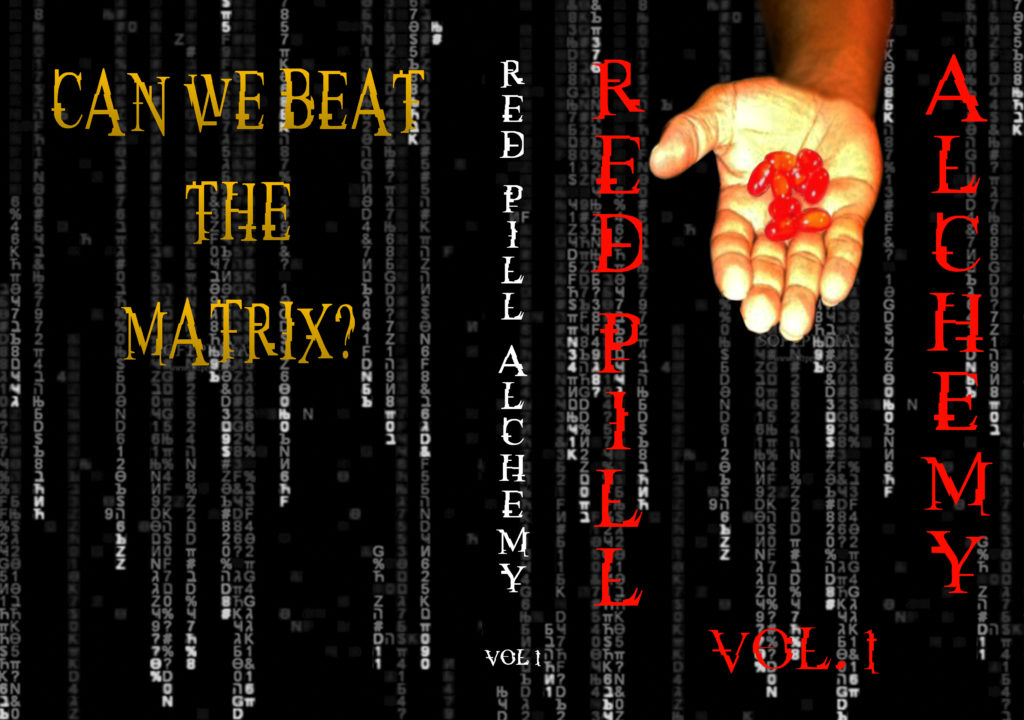
https://www.amazon.com/s?k=dewayne+hendrix&ref=nb_sb_noss
Sources
https://www.livescience.com/7899-moon-myths-truth-lunar-effects.html
https://www.britannica.com/topic/moon-worship



